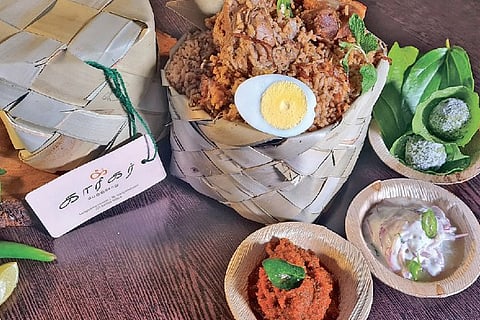

Chennai
Perunchoru which translates to a big meal originally used wild boar meat to feed the soldiers in the Chera-era. Inspired by perunchoru, Chennai-based cloud restaurant Karigar Biryani started serving a version of the age-old dish with mutton as a substitute for wild boar.
“We decided not to do the traditional version of the biryani and wanted a regional version of the same. We spoke to multiple people and a few food historians regarding the type of biryani. We figured out that biryani originated way before the Mughal period was found in south India, during the Chera rule. In the Chera empire, wild boar meat was used with a rice-based dish which could be transported everywhere.
The palm leaves boxes that we use right now are how they used to pack food back in the days to feed the soldiers,” says Girish Subash, co-founder of Karigar Biryani along with his friend Kannan Velayutham. Speaking about perunchoru and its ingredients, Girish says, “We found out there are a few confidential ingredients they use for perunchoru, which we incorporated and tried to bring it for all our biryanis. This is when we understood the reason behind using wild boar meat by the Cheras — we tried several types of meat for the biryani, but the ingredients were too strong that it became nauseating to consume. The only meat which was able to absorb all the ingredients was mutton and it, in turn, elevated the flavour. We use similar ingredients which are used for the mutton biryani for the thokku that comes as an accompaniment along with the biryani.
The spices used for perunchoru are not something you get in traditional shops but in naattu marundhu kadai and the rice used is a mixture of mappila samba and seeraga samba rice. Our mutton Karigar perunchoru is served with a special thokku, raita and paan ladoo packed in a palm leaf box.” Girish and Kannan had connected during the lockdown to set up a cloud restaurant, as restaurateurs were badly affected by the pandemic and the lockdown that followed it. “I run a restaurant called Fromage in Chennai; I got in touch with Kannan who is based in Thiruvannamalai during the lockdown. We connected and were looking to start a cloud restaurant. We did not want to go in for a traditional item already available in the market. Starting a biryani brand in Chennai is a scary concept as we were against huge players in the market.
We wanted to be different and unique instead of trying to sell a package of biryani traditionally,” adds Girish. In an attempt to make the packaging eco-friendly and reusable, they went to Thoothukudi where they found residents practice the art of palm leaf weaving and decided to use it for packaging. Inspired by these artisans, the duo came up with the name Karigar which translates to artisans. Explaining the story behind the packaging, Girish informs, “The packaging comes directly from the villages around Thoothukudi belt like Vembar. While travelling to Thoothukudi this time we came across only 10 per cent of the people making palm leaf boxes when compared to those making them five years ago.
When we reached out to them, they mentioned that this industry had died out because of industrialisation. We went and met those artisans who made palm leaf boxes, which is when we decided the name for the brand. We finalised on this and made sure that the packaging is favourable to the customers without any loss of flavour, heat and these boxes are eco-friendly and reusable.” After working on Karigar Biryani from July last year, the duo launched the cloud kitchen on December 10, 2020.
Visit news.dtnext.in to explore our interactive epaper!
Download the DT Next app for more exciting features!
Click here for iOS
Click here for Android